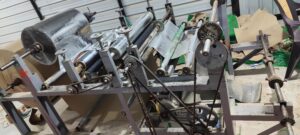Paper plate raw material making laminated paper plates are a type of disposable tableware that has a thin layer of plastic or bioplastic on the surface to make them more resistant to liquids and oils. The lamination process can also add colours and designs to the paper plates. Here is a brief overview of how laminated paper plates are made:
- The raw material for paper plates is usually wood pulp, which is obtained by breaking down wood fibres with hot water and chemicals. The pulp is then filtered, bleached, and dried to form a brown or white paper sheet.
- The paper sheet is then cut into circular shapes by a special machine that has paper-plate molds on it. The machine also presses and dries the paper circles to make them more rigid and smooth.
- The paper circles are then coated with a thin layer of plastic or bioplastic film, such as PLA or cornstarch, by another machine that uses heat and pressure to bond the film to the paper. The film can be transparent or coloured and can have different patterns or logos printed on it.
- The laminated paper plates are then packed and shipped to the customers or retailers.
Laminated paper plates have some advantages over non-laminated ones, such as:
- They are more durable and can hold hot, wet, or oily foods without leaking or breaking.
- They are more attractive and can have various designs and colours to suit different occasions and preferences.
- They are more hygienic and can prevent bacteria and germs from contaminating the food.
- They are maintenance free and less chance of damaged while transportation.
- They looks good in finished paper plates.
However, laminated paper plates also have some disadvantages, such as:
- They are more expensive and require more energy and resources to produce than non-laminated ones.
- They are less eco-friendly and biodegradable than non-laminated ones, especially if they use petroleum-based plastics that do not decompose easily in landfills or composts.
- They are not microwave-safe and can melt or release harmful chemicals when heated.
FAQ for Paper plate raw material making process:
- What is the process of manufacturing paper plates? The process involves breaking down wood into pulp, filtering and bleaching the pulp, extruding and molding the pulp into paper-plate shapes, and drying and cutting the paper plates.
- What are the different types of paper plates? Paper plates can be made from various materials, such as wood pulp, sugar-cane fibers, or other vegetable materials. Each type has different qualities, such as strength, resistance to heat and moisture, and environmental impact.
- What are the resources required to start a paper plate business? To start a paper plate business, you need to have land or building for rent, current supply, raw material, paper plate machine, workers, project report, registration, documents, and licenses.
- How to select a paper plate making machine? There are different varieties of paper plate making machines, such as single die, double die, or multiple die, automatic or semi-automatic, and different production capacities. You need to consider your budget, market demand, and types of paper plates you want to produce. You can also look for paper plate machines with buy back agreement.
-
What are the environmental benefits of using paper plates over plastic or styrofoam plates? Paper plates are biodegradable and compostable, which means they can be easily disposed of without harming the environment. Plastic and styrofoam plates, on the other hand, are non-biodegradable and can take hundreds of years to decompose, releasing harmful chemicals and microplastics into the soil and water. Paper plates also reduce the carbon footprint of the paper industry, as they use less energy and water to produce than other paper products.
-
What are the challenges and opportunities of the paper plate industry in India? The paper plate industry in India faces several challenges, such as the lack of awareness and demand for paper plates, the high cost and scarcity of raw materials, the low quality and durability of paper plates, the competition from other disposable products, and the regulatory and legal hurdles. However, there are also many opportunities for the paper plate industry, such as the growing population and urbanization, the increasing disposable income and consumption, the rising awareness and preference for eco-friendly products, the government initiatives and incentives, and the potential for innovation and diversification.
-
How to market and sell paper plates effectively? Some of the strategies to market and sell paper plates effectively are:
- Identify your target market and customer segments, such as hotels, restaurants, caterers, event organizers, households, etc.
- Conduct market research and analysis to understand the needs, preferences, and expectations of your customers, as well as the strengths, weaknesses, opportunities, and threats of your competitors.
- Develop a unique selling proposition (USP) and a brand identity that highlight the benefits and features of your paper plates, such as quality, design, price, convenience, eco-friendliness, etc.
- Create a marketing plan and budget that outline the objectives, strategies, tactics, and metrics of your marketing activities, such as advertising, promotion, distribution, pricing, etc.
- Implement and monitor your marketing plan and evaluate its effectiveness and efficiency, using tools such as feedback, surveys, sales reports, etc.

Sources:
Process of Manufacturing Paper Plates | Bizfluent
What You Should Know About Paper Plate Materials? - Ecoure
Manufacturing Process, Advantage and Disadvantages of Laminates
Guide to Types of Lamination: Matte, Gloss & More